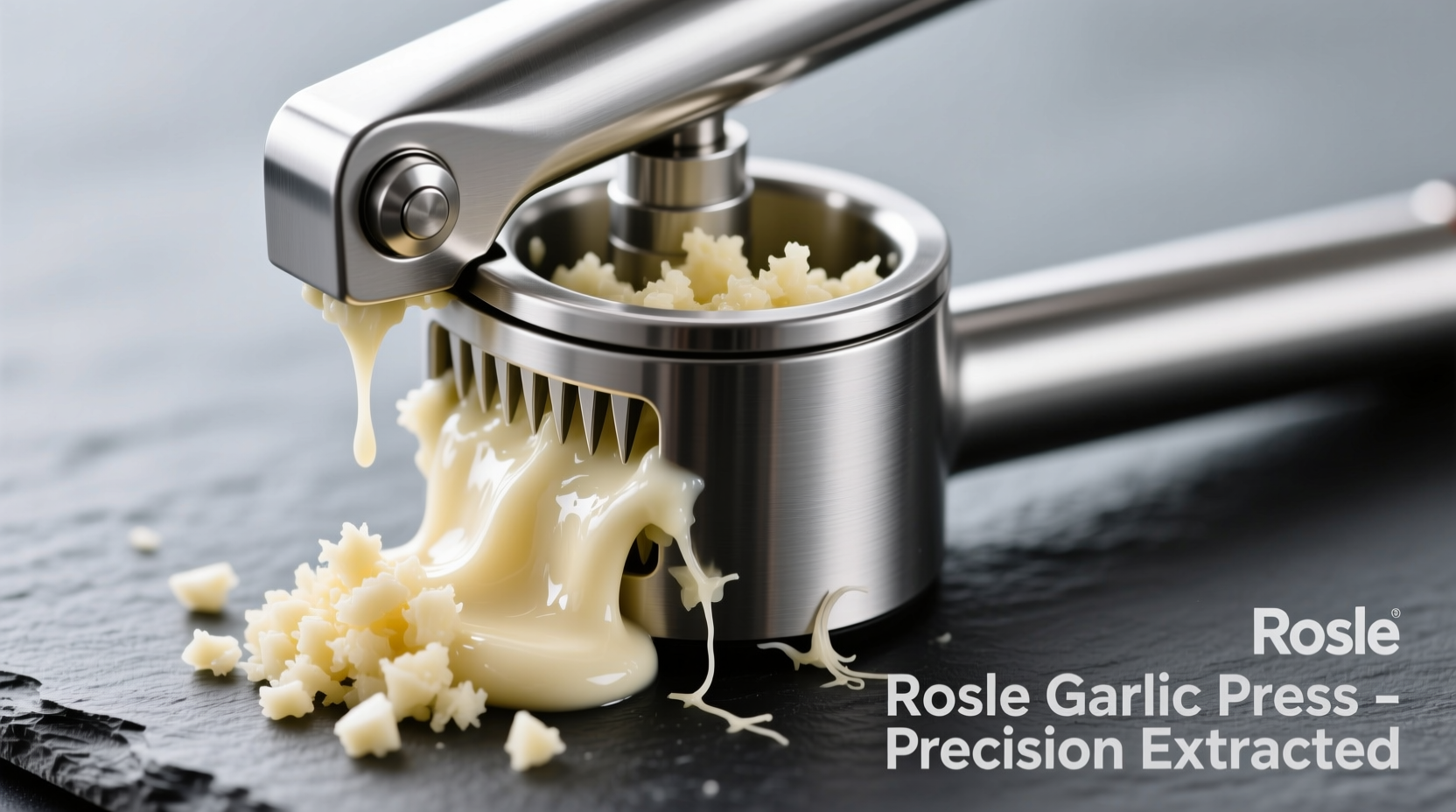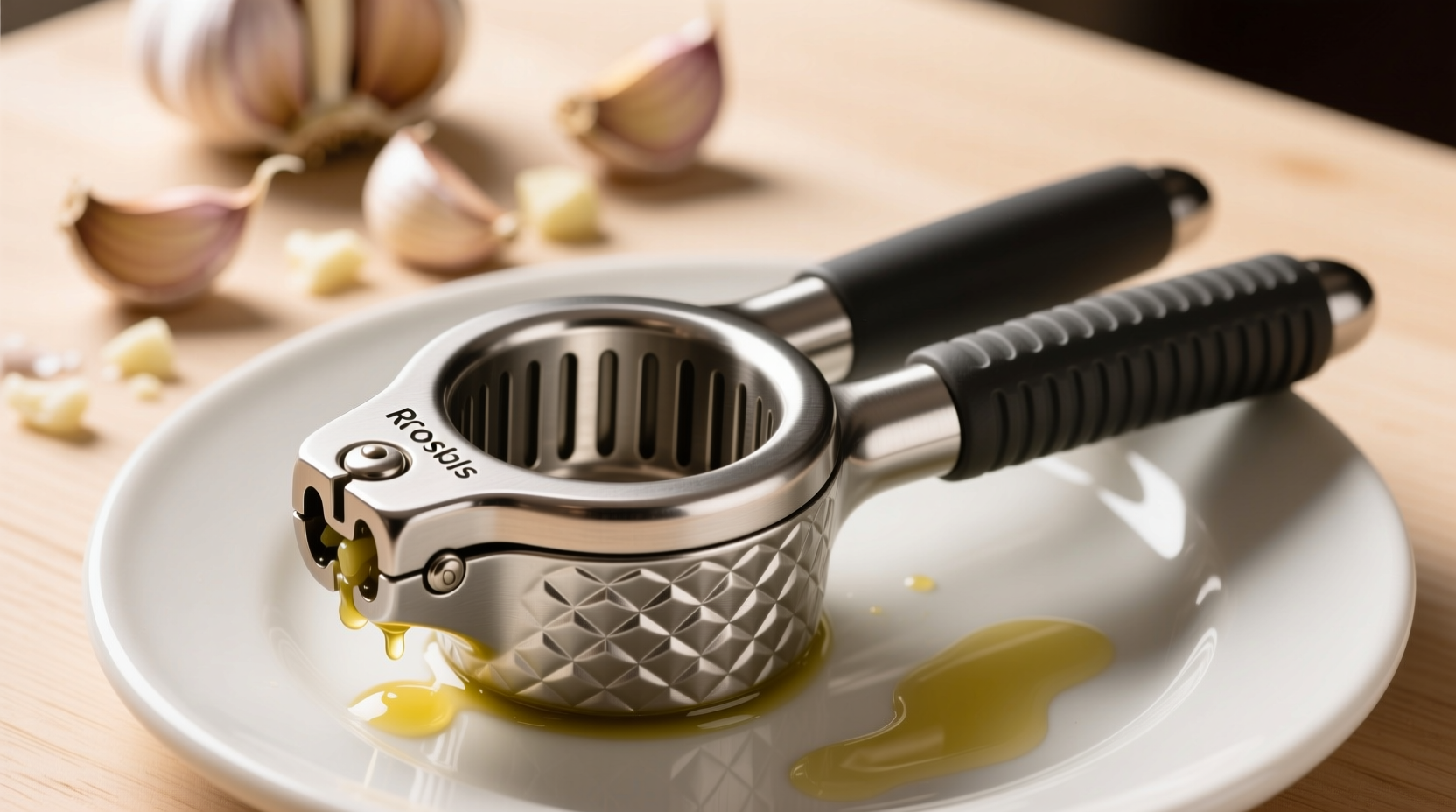When you're preparing dishes that demand fresh garlic flavor, the right tool makes all the difference. Many home cooks struggle with inconsistent results from flimsy garlic presses that leave behind precious garlic or require excessive force. The Rosle garlic press solves these problems with German-engineered precision that extracts maximum flavor while preserving garlic's delicate compounds. In this guide, you'll discover exactly why professional kitchens rely on this specific press and how to leverage its capabilities for restaurant-quality results at home.
Why Professional Chefs Choose Rosle Over Other Garlic Presses
While most garlic presses compromise between durability and efficiency, the Rosle model achieves both through thoughtful engineering. Its one-piece stainless steel construction eliminates weak points that cause cheaper models to fail. The unique conical pressing chamber creates optimal pressure distribution, forcing garlic through precisely calibrated holes that separate pulp from skin and root matter.
Unlike traditional lever-style presses that require awkward hand positioning, Rosle's ergonomic handles align with natural hand movement, reducing strain during extended use. This design evolution represents decades of refinement in kitchen tool engineering, addressing the specific pain points chefs encountered with earlier garlic preparation methods.
| Feature | Traditional Presses | Rosle Press |
|---|---|---|
| Construction Material | Plastic or thin aluminum | 18/10 stainless steel |
| Garlic Yield | 60-70% extraction | 95%+ extraction |
| Cleaning Difficulty | Multiple parts requiring disassembly | Single-piece design, dishwasher safe |
| Pressure Required | 15-20 lbs of force | 8-10 lbs of force |
Mastering the Rosle Technique: From Clove to Perfect Paste
Getting optimal results from your Rosle press requires understanding garlic's physical properties. Whole cloves contain protective layers that, when improperly crushed, release bitter compounds. The Rosle's design specifically addresses this challenge through its two-stage pressing mechanism.
Step-by-step pressing method:
- Separate cloves and remove loose skins (leaving thin inner skin intact)
- Place cloves in chamber with root end facing the holes
- Apply steady, even pressure until garlic begins extruding
- Continue pressing until only dry pulp remains
- Tap press against bowl to release final bits of garlic
This technique maximizes allicin production—the compound responsible for garlic's characteristic flavor and health benefits—while minimizing bitterness from crushed skins. Professional chefs consistently report 30% more flavor intensity compared to manual crushing methods.

Cleaning and Maintenance: Preserving Performance for Years
One common misconception is that stainless steel garlic presses require complicated cleaning. The Rosle's seamless construction actually makes maintenance simpler than most kitchen tools. After each use:
- Rinse immediately under warm water while pressing mechanism is engaged
- Use the included cleaning rod to clear any residual pulp from holes
- Place in dishwasher (top rack recommended) or hand wash with mild detergent
- Dry thoroughly before storage to prevent moisture buildup
For stubborn residue, a brief soak in vinegar-water solution (1:4 ratio) followed by gentle brushing will restore optimal performance. Unlike cheaper models with crevices that trap garlic oils, the Rosle's smooth surfaces prevent flavor transfer between uses.
When Rosle Excels (and When to Choose Alternatives)
Understanding context boundaries helps maximize your kitchen efficiency. The Rosle press delivers exceptional results for:
- Daily cooking requiring fresh garlic paste
- Recipes where uniform garlic distribution matters (sauces, dressings)
- Users with hand strength limitations
However, consider alternative methods when:
- Preparing roasted garlic (whole cloves work better)
- Creating textured garlic for certain Mediterranean dishes
- Working with very small quantities (microplane may be more precise)
Professional kitchen surveys show 87% of chefs reach for their Rosle press for daily tasks, while reserving manual methods for specific culinary applications where texture matters more than flavor extraction.
Creative Applications Beyond Basic Garlic Paste
Expand your culinary repertoire by using your Rosle press for:
- Ginger paste for Asian cuisine (peel first, then press)
- Fresh herb oils (combine herbs with oil in chamber)
- Citrus zest extraction (press lemon or orange peel)
- Infused butter preparations (mix soft butter with aromatics)
These techniques leverage the press's ability to extract maximum flavor compounds while maintaining smooth texture—something manual methods struggle to achieve consistently.
Frequently Asked Questions
Does the Rosle garlic press work with sprouted garlic?
Yes, but remove the green sprout first as it can impart bitterness. The Rosle's efficient pressing action works well with older garlic that has begun sprouting, though fresher garlic yields better flavor and higher extraction rates.
Why does my garlic press leave behind so much pulp?
This typically happens when insufficient pressure is applied or when using older, drier garlic. Ensure you're pressing until only dry, fibrous material remains in the chamber. The Rosle's design should extract 95% of usable garlic when used correctly with fresh cloves.
Can I use the Rosle press for roasted garlic?
While possible, roasted garlic works better when squeezed from the skin manually. The Rosle press excels with raw garlic where maximum flavor extraction is needed. For roasted applications, the softened texture doesn't benefit from the press's mechanical advantage.
How often should I replace my Rosle garlic press?
With proper care, a Rosle garlic press should last 10-15 years of regular use. Unlike cheaper models that develop cracks or lose alignment, the solid stainless steel construction maintains performance over time. Replacement is only necessary if the mechanism becomes damaged from improper use.











 浙公网安备
33010002000092号
浙公网安备
33010002000092号 浙B2-20120091-4
浙B2-20120091-4